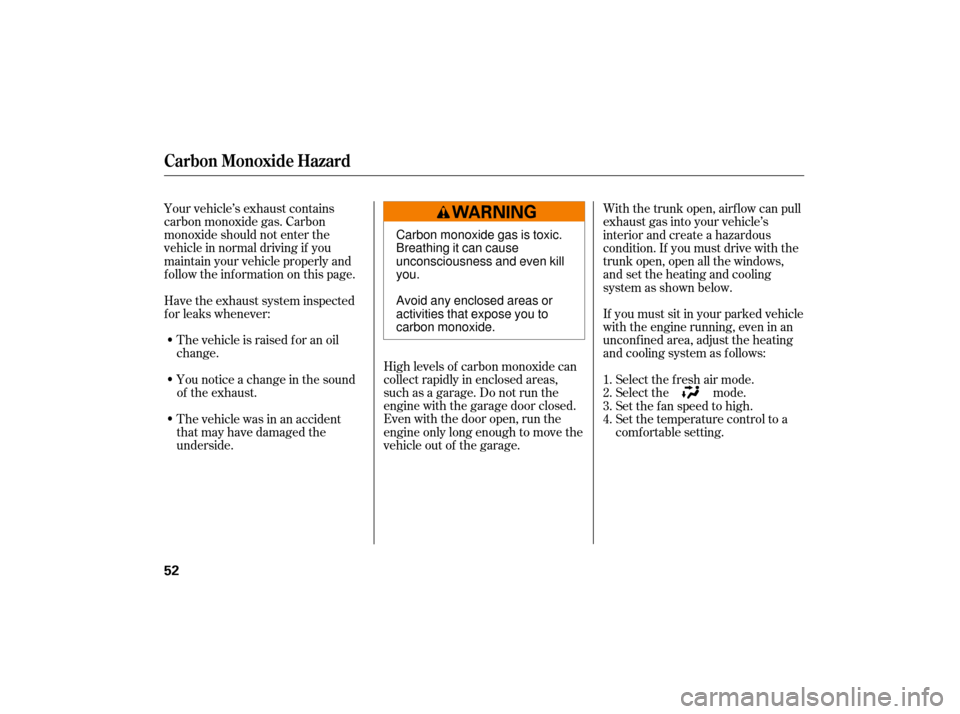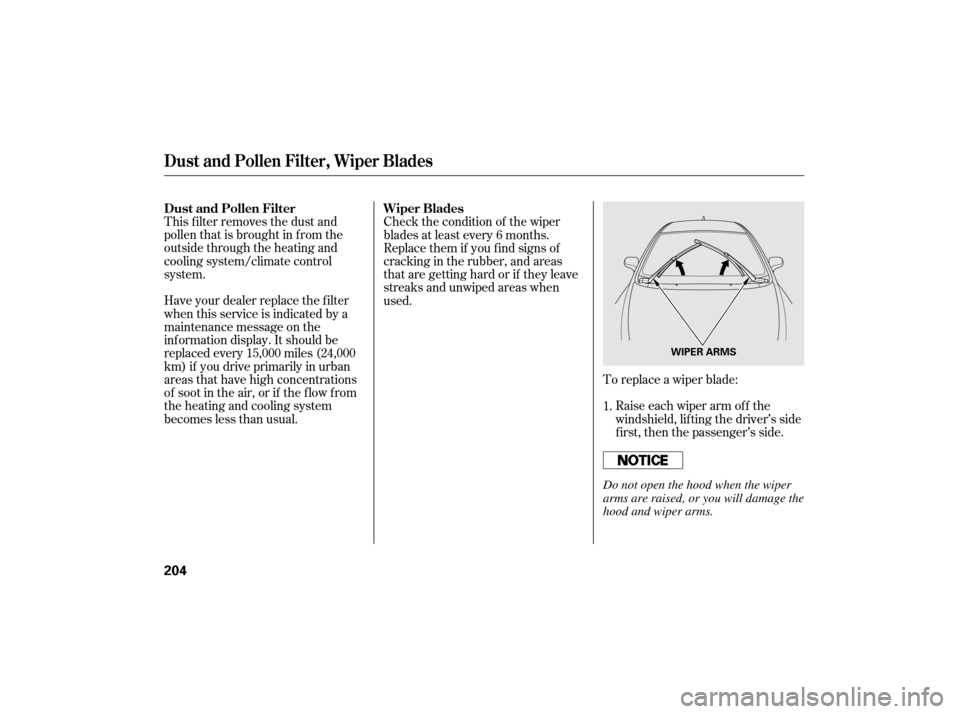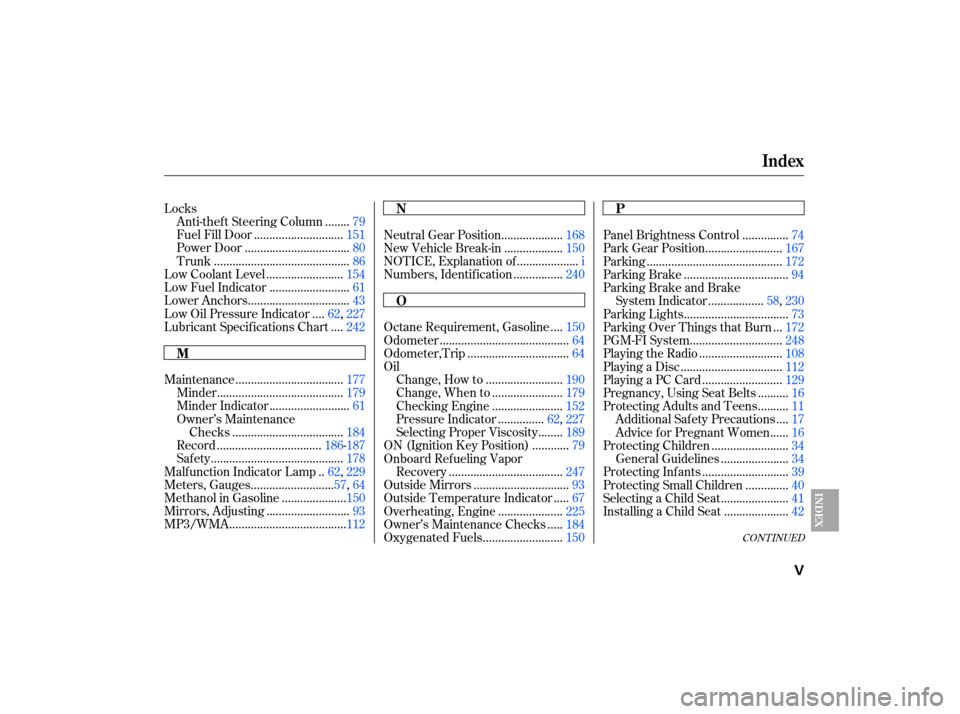2007 HONDA CIVIC HYBRID heating
[x] Cancel search: heatingPage 55 of 268

Your vehicle’s exhaust contains
carbon monoxide gas. Carbon
monoxide should not enter the
vehicle in normal driving if you
maintain your vehicle properly and
f ollow the inf ormation on this page.High levels of carbon monoxide can
collect rapidly in enclosed areas,
such as a garage. Do not run the
engine with the garage door closed.
Even with the door open, run the
engine only long enough to move the
vehicle out of the garage.If you must sit in your parked vehicle
with the engine running, even in an
unconf ined area, adjust the heating
and cooling system as f ollows:
The vehicle is raised f or an oil
change.
Have the exhaust system inspected
f or leaks whenever:
You notice a change in the sound
of the exhaust.
The vehicle was in an accident
that may have damaged the
underside. With the trunk open, airf low can pull
exhaust gas into your vehicle’s
interior and create a hazardous
condition. If you must drive with the
trunk open, open all the windows,
and set the heating and cooling
system as shown below.
Select the f resh air mode.
Select the mode.
Set the f an speed to high.
Set the temperature control to a
comfortable setting.
1.
2.
3.
4.
Carbon Monoxide Hazard
52
Carbon monoxide gas is toxic.
Breathing it can cause
unconsciousness and even kill
you.
Avoid any enclosed areas or
activities that expose you to
carbon monoxide.
Page 102 of 268

The standard audio system has
many f eatures. This section
describes those f eatures and how to
use them. (If you have an optional
audio system, ref er to the operating
instructions that came with it.) The heating and air conditioning
system in your vehicle provides a
comf ortable driving environment in
all weather conditions.
Your vehicle has an anti-theft audio
system that requires a code number
to enable it.
The security system helps to dis-
courage vandalism and thef t of your
vehicle..............................
Climate Control .100
................................
Audio System .106
..........................
Playing the Radio .109
................................
Playing a Disc .112
.......
Disc Player Error Messages .118
..........................
Setting the Clock .119
Playing the Radio (Vehicles with
..................
Navigation System) .121
Playing a Disc (Vehicles with ..................
Navigation System) .125
Playing a PC Card (Vehicles with ..................
Navigation System) .129
Disc Player Error Messages (Vehicles with Navigation ..................................
System) .138
............................
Radio Reception .139
..................
Protecting Your Discs .141
.................
Radio Thef t Protection .142
................
Remote Audio Controls .143
............................
Security System .144
...............................
Cruise Control .145
Features
Features
99
Page 104 of 268

Only on models equipped withNavigation System
The climate control system f or your
vehicle can also be operated using
the voice control system. See the
NavigationsectioninyourQuick
Start Guide f or an overview of this
system and the Navigation System
manual f or complete details.
The automatic climate control
system adjusts the f an speed and
airflow levels to maintain the interior
temperature you select. You can manually select various
f unctions of the climate control
system when it is in f ull automatic
mode. All other f eatures remain
automatically controlled.
Making any manual selection causes
thewordAUTOinthedisplaytogo
out.
Turn this dial to increase or decrease
the fan speed and airflow.
Turning this dial clockwise increases
the temperature of the airflow.
Set the desired temperature by
turning the temperature control
dial. You will see AUTO in the
system’s display. Press the AUTO button. The system automatically selects the
proper mix of conditioned and/or
heated air that will, as quickly as
possible, raise or lower the interior
temperature to your pref erence.
When you set the temperature to its
lower limit ( ) or its upper limit
( ), the system runs at f ull
cooling or heating only. It does not
regulate the interior temperature.
In cold weather, the fan will not
come on automatically until the
heater starts to develop warm air.
In ‘‘AUTO’’ mode, the air conditioner
may not work if the humidity inside
the vehicle is low. To activate the air
conditioner, press A/C button.
Voice Control System Semi-automatic Operation
Using A utomatic Climate Control Fan Control Dial
T emperature Control Dial
Climat e Cont rol
Features
101
Page 105 of 268

Airf low is divided between
the f loor vents and def roster vents at
the base of the windshield.
Air f lows f rom the def roster
vents at the base of the windshield.
When you select , the system
automatically switches to fresh air
mode and turns on the A/C.
In AUTO mode, the system controls
the airf low direction automatically
between the dashboard vents and
the f loor vents.
This button turns the air
conditioning on and of f . The
indicatorinthebuttonisonwhen
the A/C is on.
When the recirculation indicator is
on, air f rom the vehicle’s interior is
sent throughout the system again.
To select recirculation mode when
driving through dusty or smoky
conditions, then return to fresh air
mode.
The outside air intakes f or the
heating and cooling system are at
the base of the windshield. Keep this
area clear of leaves and other debris.
When the f lesh air indicator is on, air
is brought in f rom the outside of the
vehicle. Thesystemshouldbeleftinfresh
air mode under almost all conditions.
Keeping the system in recirculation
mode, particularly with the A/C of f ,
can cause the windows to fog up.
Use the mode control buttons to
select the vents air flows from. Some
air will f low f rom the dashboard
corner vents in all modes.
Air flows from the center
and corner vents in the dashboard.
Airf low is divided between
the vents in the dashboard and the
f loor vents.
Air f lows f rom the f loor
vents. When you select , the
system automatically switches to
f resh air mode.
Air Conditioning (A/C) Button
Recirculation Button
Fresh Air Button
Mode Control Button
Climat e Cont rol
102
Page 207 of 268

This f ilter removes the dust and
pollenthatisbroughtinfromthe
outside through the heating and
cooling system/climate control
system.
Have your dealer replace the filter
when this service is indicated by a
maintenance message on the
inf ormation display. It should be
replaced every 15,000 miles (24,000
km) if you drive primarily in urban
areas that have high concentrations
of soot in the air, or if the f low f rom
the heating and cooling system
becomeslessthanusual.Check the condition of the wiper
blades at least every 6 months.
Replace them if you f ind signs of
cracking in the rubber, and areas
that are getting hard or if they leave
streaks and unwiped areas when
used.
To replace a wiper blade:Raise each wiper arm off the
windshield, lif ting the driver’s side
first, then the passenger’s side.
1.
Dust and Pollen Filter, Wiper Blades
Dust and Pollen Filter
Wiper Blades
204
WIPER ARMS
Do not open the hood when the wiper
arms are raised, or you will damage the
hood and wiper arms.
Page 262 of 268

CONT INUED
...................................
Fan, Interior .101
...........................................
Features .99
....................
Filling the Fuel Tank .151
Filters
.........................
Dust and Pollen .204
...............................................
Oil .190
.............
Flashers, Hazard Warning .74
...................
Flat Tire, Changing a .217
Fluids
..........
Automatic Transmission .195
..........................................
Brake .196 ..................
Windshield Washer .194
FM Stereo Radio ...................................
Reception .139
..........................
Four-way Flashers .74
..............................
Front Airbags . 9, 21
.................................................
Fuel .150
......................
Fill Door and Cap .151
...........................................
Gauge .66
................
Octane Requirement .150
...............................
Oxygenated .150
........................
Reserve Indicator .61
........................
Tank, Filling the .151
.....................
Fuses, Checking the .231
...............
Gas Mileage, Improving .154
..........................................
Gasohol .150
.........................................
Gasoline .150
...............
Fuel Reserve Indicator .61
...........................................
Gauge .66
................
Octane Requirement .150
........................
Tank, Filling the .151
................
Gas Station Procedures .151
..........
DOT Tire Quality Grading .244
...........
Driver and Passenger Safety .5
...........................................
Driving .163
....................................
Economy .154
..................
Dust and Pollen Filter .204
..............................
Economy, Fuel .154
............
Emergencies on the Road .215
.............
Battery, Jump Starting .223
...........
Brake System Indicator .230
................
Changing a Flat Tire .217
.....
Charging System Indicator .228
..................
Checking the Fuses .231
.....
Low Oil Pressure Indicator .227
...
Malf unction Indicator Lamp .229
..................
Overheated Engine .225
...........................
Emergency Brake .94
......................
Emergency Flashers .74
......................
Emergency Towing .237
............
Emergency Trunk Opener .86
.......................
Emissions Controls .247
.............
Emissions Testing, State .250
Engine
....
Coolant Temperature Gauge .65 ..............
Engine Speed Limiter .168
Malf unction Indicator
................................
Lamp . 62, 229
........
Oil Pressure Indicator . 62, 227
..............
Oil, What Kind to Use .189
...............................
Overheating .225
............................
Specif ications .242
.......................................
Starting .165
.
Evaporative Emissions Controls .247
...............................
Exhaust Fumes .52
Expectant Mothers, Use of Seat
........................................
Belts by .16
Index
F
E
G
INDEX
III
Page 264 of 268

CONT INUED
Locks.......
Anti-thef t Steering Column .79
............................
Fuel Fill Door .151
.................................
Power Door .80
...........................................
Trunk .86
........................
Low Coolant Level .154
.........................
Low Fuel Indicator .61
................................
Lower Anchors .43
...
Low Oil Pressure Indicator . 62, 227
...
Lubricant Specif ications Chart .242
..................................
Maintenance .177
........................................
Minder .179
.........................
Minder Indicator .61
Owner’s Maintenance
...................................
Checks .184
.................................
Record . 186-187
..........................................
Saf ety .178
.
Malfunction Indicator Lamp . 62, 229
..........................
Meters, Gauges .57, 64
....................
Methanol in Gasoline .150
..........................
Mirrors, Adjusting .93
.....................................
MP3/WMA .112 ...................
Neutral Gear Position .168
..................
New Vehicle Break-in .150
...................
NOTICE, Explanation of .i
...............
Numbers, Identif ication .240
...
Octane Requirement, Gasoline .150
.........................................
Odometer .64
................................
Odometer,Trip .64
Oil
........................
Change, How to .190
......................
Change, When to .179
......................
Checking Engine .152
..............
Pressure Indicator . 62, 227
.......
Selecting Proper Viscosity .189
...........
ON (Ignition Key Position) .79
Onboard Ref ueling Vapor
....................................
Recovery .247
..............................
Outside Mirrors .93
....
Outside Temperature Indicator .67
....................
Overheating, Engine .225
....
Owner’s Maintenance Checks .184
.........................
Oxygenated Fuels .150 ..............
Panel Brightness Control .74
........................
Park Gear Position .167
...........................................
Parking .172
.................................
Parking Brake .94
Parking Brake and Brake
.................
System Indicator . 58, 230
.................................
Parking Lights .73
..
Parking Over Things that Burn .172
.............................
PGM-FI System .248
..........................
Playing the Radio .108
................................
Playing a Disc .112
.........................
Playing a PC Card .129
.........
Pregnancy, Using Seat Belts .16
.........
Protecting Adults and Teens .11
...
Additional Safety Precautions .17
.....
Advice f or Pregnant Women .16
........................
Protecting Children .34
.....................
General Guidelines .34
...........................
Protecting Inf ants .39
.............
Protecting Small Children .40
.....................
Selecting a Child Seat .41
....................
Installing a Child Seat .42
Index
M N
O
P
INDEX
V
Page 265 of 268

...........
Protecting Larger Children .48
...................
Radiator Overheating .225
............
Radio/CD/Sound System .106
Radio/CD/PC Card Sound
........................................
System .121
...................
Readiness Codes . 229, 250
Rear Lights, Bulb ......................
Replacement . 200, 201
............................
Rear View Mirror .93
.................
Rear Window Def ogger .75
................
Reclining the Seat-backs .90
.......................
Remote Transmitter .87
Replacement Inf ormation
..............
Dust and Pollen Filter .204
................
Engine Oil and Filter .190
..........................................
Fuses .232
................................
Light Bulbs .197
................
Maintenance Minder .179
...........................................
Tires .207
.............................
Wiper Blades .204
Replacing Seat Belts Af ter a ............................................
Crash .20 Reserve Tank, Engine
...............................
Coolant . 153, 192
...............................
Restraint, Child .34
..................
Reverse Gear Position . 168
................................
Rotation, Tire .210
..................................
Safety Belts . 8, 18
............
Safety Defects, Reporting . 254
.................................
Saf ety Features .7
...........................................
Airbags .9
.......................................
Seat Belts .8
.............
Saf ety Labels, Location of . 53
..............................
Saf ety Messages .iii
.....................................
Seat Belts . 8, 18
...............
Additional Information . 18
Automatic Seat Belt ...............................
Tensioners .19
................
Lap/Shoulder Belt . 14, 18
........................
Mainte nance . 20, 203
Reminder Light and ................................
Beeper . 18, 58
...................
System Components . 18
...............
Use During Pregnancy . 16Wearing a Lap/Shoulder
.....................................
Belt . 14, 18
........................
Seats, Adjusting the .89
............................
Security System .144
...............................
Serial Number .240
...........................
Service Intervals .185
.............................
Service Manual .255
.........
Service Station Procedures . 151
..........................
Setting the Clock .119
...
Shif t Lever Position Indicators . 166
........................
Shif t Lock Release .169
................................
Side Airbags . 9, 28
..........................
Off Indicator . 30, 59
......................
Side Curtain Airbags .29
Side Marker Lights, Bulb ..............................
Replacement .199
...............................
Signaling Turns .73
.....................................
Snow Tires .211
................................
Sound System .106
Spare Tire ......................................
Inf lating .216
............................
Specif ications .243
....................
Specif ications Charts . 242
................................
Speed Control .145
Speed-Sensitive Volume .......
Compensation (SVC) . 111, 124
Index
R
S
VI